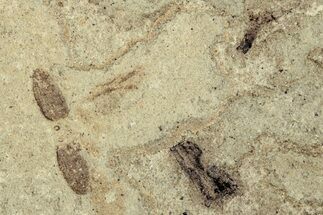This Specimen has been sold.
Sweet - Gosiutichthys parvus Multiple Plate
Here is a nice example of the schooling herring Gosiutichthys parvus from the Laney Shale Member of the Green River Formation. There are 5 complete fish preserved and several partials. The fossil fish are well preserved and contrast well against the yellow matrix. The plate displays nicely on the included stand.
Gosiutichthys parvus is an extinct, ray-finned Clupeid thought to have darted in schools across the menacing surface waters of Middle Eocene lakes. G. parvus, pried from lacustrine sediments dated to 45 milliona years ago, spent its brief life dodging predatory fish and ravenous reptiles. Though small and related to herrings and sardines like Knightia, G. parvus
G. parvus glided through Eocene (55.8-33.8 mya) waters surrounded by sycamore forests filled with fantastic creatures such as flying ants the size of hummingbirds. Like other Clupeids, G. parvus likely laid a multitude of eggs on the lake's surface. After hatching, the larvae would have lived among the plankton, feasting on algae and diatoms until it developed a swim bladder connected to the gut by a pneumatic duct. These features are characteristic for this prolific family of food fish.
G. parvus is quarried from the ancient Lake Gosiute, differentiating it from other Green River Formation fossils associated with relic Lake Uinta and the famously anoxic Fossil Lake. Lake Gosiute is not associated with the Lower Eocene Diplomystus and Knightia. However, it is the only locale of the three with catfish and suckers entombed in its deeper strata. The preservation of atypical biota and morphology within distinctive strata reinforces the likelihood that G. parvus thrived in an ecological niche that varied somewhat from its herring cousins.
Though Lake Gosiute retreated periodically during the Laramide Orogeny, the Laney Shale Member beds are associated with lake expansion. Noted for rich oil shale resources, Laney Shale deposition occurred in the middle of a climatic shift from the warm early Eocene to the cooler, drier conditions that pervaded the northern latitudes by the end of the Eocene.
G. parvus glided through Eocene (55.8-33.8 mya) waters surrounded by sycamore forests filled with fantastic creatures such as flying ants the size of hummingbirds. Like other Clupeids, G. parvus likely laid a multitude of eggs on the lake's surface. After hatching, the larvae would have lived among the plankton, feasting on algae and diatoms until it developed a swim bladder connected to the gut by a pneumatic duct. These features are characteristic for this prolific family of food fish.
G. parvus is quarried from the ancient Lake Gosiute, differentiating it from other Green River Formation fossils associated with relic Lake Uinta and the famously anoxic Fossil Lake. Lake Gosiute is not associated with the Lower Eocene Diplomystus and Knightia. However, it is the only locale of the three with catfish and suckers entombed in its deeper strata. The preservation of atypical biota and morphology within distinctive strata reinforces the likelihood that G. parvus thrived in an ecological niche that varied somewhat from its herring cousins.
Though Lake Gosiute retreated periodically during the Laramide Orogeny, the Laney Shale Member beds are associated with lake expansion. Noted for rich oil shale resources, Laney Shale deposition occurred in the middle of a climatic shift from the warm early Eocene to the cooler, drier conditions that pervaded the northern latitudes by the end of the Eocene.
SPECIES
Gosiutichthys parvus
LOCATION
LaBarge, Wyoming
FORMATION
Green River Formation - Laney Shale Member
SIZE
Largest is 2", Plate is 3.5x3"
CATEGORY
SUB CATEGORY
ITEM
#180
We guarantee the authenticity of all of our specimens.
 Reviews
Reviews












